The cuff is soft: fit, care and application on the site
Soft cuff not so long ago was considered a weed. They tore her out and tried with all their might to remove her from the infield. Now its importance in horticulture has changed. It is recommended to plant it for decorating a garden and various flower beds, as well as mixborders. Therefore, before planting an unpretentious shrub, you should familiarize yourself with its reproduction, planting methods and care tips.
Content:
- Description of the plant and an overview of the best varieties
- Growing conditions for soft cuff
- Site preparation for landing
- Reproduction and planting
- Care Tips
- Diseases and pests
- Plant properties
- Use in landscape design
Description of the plant and an overview of the best varieties
The soft cuff in nature acts as a perennial plant, herbaceous type. The bush belongs to the genus Rosaceae. Its root system goes deep into the ground. The terrestrial growth of the shrub is no more than 40 cm. The slight growth is compensated by the original appearance.
The foliage at the cuff is fan-shaped, but tapers somewhat towards the center. After rain, a drop of water collects in the center of the leaf and gives off a bright shine. By its appearance, the leaf blade is presented in the form of a funnel. The most original and beautiful type of ornamental plant is in the early morning. At this moment, the fallen dew shimmers in the rays of the rising sun. A distinctive feature of the cuff is that it tends to emit water droplets on its own from the surface of the sheet plate. Therefore, very often on warm summer nights, you can see leaves strewn with small droplets of moisture.
The flowering of the cuff begins from the first days of June and lasts a fairly long period - until the end of August.
The inflorescences are located on a high stalk, gather in small inflorescences, presented with an interesting greenish-yellow shade. As the flowers fade, the flower stalks gradually begin to tilt to the ground, and new buds quickly grow in their place. In wildlife, there are about 350 different varieties. They practically do not differ from each other in appearance. The only feature is the flowering period.
There are the following types of cuffs:
- Soft - the most famous and used in decorating gardens and backyards. The most interesting species are distinguished: Thriller, Golden Bouquet, Robustica, Senior, Gold Strike.
- Alpine miniature - low shrubs, reaching 20 cm. Its leaves are divided into small petals, and the lower part of the leaf is supplemented with fluffy bristles. Begins flowering from the second decade of May to mid-June.
- Siberian is a miniature shrub not exceeding 25 cm.
- Hoppe - like the Alpine species, has interesting leaves, does not grow more than 20 cm in height.
- Common - has folded foliage. Blooms in small, inconspicuous inflorescences, a short period of time. It is extremely rarely used in decoration.
- Krasnochereshkovaya - the name comes from the fact that the plant is colored red on cuttings, foliage and pedicels.The bush does not grow more than 15 cm. The leaves are covered with a slightly noticeable blue downy.
- Sparkling - outwardly similar to an ordinary cuff, but differs in a neat shrub and erect flowers. Its flowering occurs twice during the period - from May to June, and after a break, under good conditions, from August to the end of September.
Thus, the plant does not stand out with flashy colors, but attracts with the original shape of the leaf plate and unpretentious keeping conditions.
Conditions for growing soft cuff
Many gardeners believe that no special care is required to grow a soft cuff. You should not judge so and leave the plant to the mercy of fate. The shrub can grow both in the semi-darkness of trees and in the open sun. Before planting, it is recommended to choose a fertile, loose, rich in nutrients and mineral fertilizers the ground. Fresh soil fertilized with rotted humus is best suited. If there is a small percentage of clay in the soil, then the shrub will only benefit from this.
Recommended level soil acidity for the cuff - pH-6.
The plant can grow in direct sunlight, but in this case it will require a lot of moisture for a normal appearance. An ideal place for chic growth and development is an area with diffused light in the morning and evening moments, and in the midday heat with good shading.
If you choose partial shade, then watering can be practically not carried out. The cuff will have enough moisture that was acquired after atmospheric precipitation. Otherwise, in a sunny place, you will have to water every day as the soil dries out under the hot rays of the sun. The cuff is not afraid of severe frosts, it tolerates them well and firmly. But to better protect root system, for the winter it is recommended to use straw mulching.
Thus, little plant maintenance is directly needed. The main thing is to place it in a favorable place and feed it before disembarking. After that, periodically monitor the need for nutrient moisture and mineral fertilizers.
Site preparation for landing
A place with neutral acidity is suitable for planting, with a high saturation with humus. It is imperative that the soil is loose. This is necessary in order for the roots to develop faster, take root, receive a sufficient amount of nutrient moisture and the necessary oxygen.
During the preparation of the site for planting, the air permeability and moisture of the soil should be monitored.
The main thing is not to allow excessive dampness, from which pathogenic bacteria of the fungal type develop in the soil. When planting seedlings of the cuff, each should be placed from each other at a distance of at least 30-35 cm. Such a gap is necessary due to the fact that the shrub grows rapidly and begins to interfere with the neighboring plant. In addition, the close location does not allow the plant to be successfully transplanted to a new place of residence.
When rooting shrubs, it is problematic to transfer them to another place. A weakly developed root system has overgrown lateral auxiliary roots. They extend over fairly large distances, entwining adjacent rhizomes and filling the territory of nearby plants. Therefore, it is recommended to plant at once on one site, not hoping to change their place of residence in the future.
Reproduction and planting
The cuff reproduces in several ways. Before planting, you should decide what is the best way to plant. Some gardeners lean towards seed, while others advise growing by dividing the shrub or by cuttings. Each gardener must independently decide on the method that suits him.
There are the following types of soft cuff reproduction:
- Seeds - produced in two ways.Using the first method - planting in open ground, the farmer sows seeds on his backyard in early spring. When grown for seedlings - seedlings are planted in prepared containers in early November. The pots should have a moist substrate and a certain air temperature created by the covered film on the flowerpot. After exactly 2 weeks, the flowerpot with seedlings should be taken out into the open air, but it should still be covered with a film. A container with planting material should be introduced only in early spring. This is necessary for the seeds to pass naturally stratification, then young shoots will have high immunity and increased resistance to diseases. After pots with seeds matured on the street are introduced, young sprouts very quickly begin to hatch. After 3 weeks, seedlings can be dived into larger flowerpots. Transplanting into open ground is carried out at a time when the root system develops well.
- Cuttings - on the shrub after flowering in June, the shoots can be separated from the main trunk together with the rosette. To release young roots, it is recommended to bury the end of the plant trunk into moist soil and place it in a room with diffused light. After 14 days, the bush can be transplanted to a permanent place of residence, the root system should already have developed enough to withstand the moment of transplantation.
- Dividing the bush - reproduction in this way can be carried out at any time. The disadvantage of this method is damage to the root system of the cuff, which leads to long-term painful rooting.
Thus, it is best to use seeds to get a new specimen. The breeding process, although a little longer, but the result is healthy, with good immunity plants that can be planted anywhere in the backyard.
Care Tips
In order for the plant to develop quickly and please with saturated forms, it is recommended to carry out simple plant care in a timely manner. The correct maintenance of the plant comes down to the application of the following rules:
- Watering - it is recommended to carry out based on weather conditions. If the summer is wet, then additional irrigation is not required, otherwise, when it is predominantly hot, then watering is mandatory.
- Top dressing - carried out in the spring, by introducing humus to the base of the plant. Other minerals are not required for further growth of the shrub.
- Pruning - it is recommended to carry out it almost constantly, as the inflorescences fade. Such buds should be removed so that new ones can grow in their place.
- Preparation for winter - it is recommended to cover the plant by laying mulch under the shrub.
It is not difficult to care for the cuff, so planting and growing it will not cause much trouble. The main thing is to perform all procedures on time and consistently, and not all in one day.
Although the cuff is considered a frost-resistant plant, it is still recommended to prepare it for winter.
In order for the shrub to tolerate a strong drop in temperature conditions, it is first required to decompose crushed peat at the base of the root system. For better insulation, you should completely cover the entire surface of the earth.
In addition, it is worth covering the plant with fallen leaves on top, or if you do not cut off the dead foliage of the shrub itself, then it will independently cover the root system. When snow falls, pile more snow onto the area where the shrub grows. In this case, the plant will be reliably shrouded in a snow mass and will not freeze out in severe frosts.
Diseases and pests
The cuff is quite resistant to various diseases. If you do not adhere to the growing conditions of the plant, then you can provoke the occurrence powdery mildew on the bush.When planted in the shade of large trees, black rust spots can be expected to appear on the shrub.
The most dangerous pests for the cuff are slugs and snails - they eat up the delicate leaves of the plant, making the shrub look unpleasant.
With a lack of sun and an increased level of humidity, mold appears on the stems and leaves of the cuff. To eliminate the spreading process, all damaged leaves should be cut off and the shrub should be transplanted to a new place of residence, preferably on a sunny one, in a short time.
After that, it is recommended to process the plant with a suitable fungicidedesigned to fight fungal diseases. After that, control the further state of the plant. If necessary, fertilize with humus.
Plant properties
In addition to decorative purposes, the cuff is used as a forage plant necessary for feeding pets. Such animals include, for example, goats, cows, rabbits. It also has melliferous qualities and medicinal properties.
Traditional medicine uses the cuff as a medicinal herb. It is used for various purposes for the preparation of decoctions and tinctures:
- The broth is recommended for the treatment of female gynecological diseases. It is used as a treatment for diseases of the kidneys and genitourinary system. Effectively acts for ailments associated with the upper respiratory tract, nasopharynx and bronchi. The broth provokes an astringent property, has an anti-inflammatory effect on the body. Especially effective is the treatment of intestinal disorders, constipation or diarrhea, as well as increased flatulence.
- Baths with decoctions, lotions and compresses have a wound healing property, provoke the regeneration of the upper layers of the epidermis in case of acne, ulcers of various etiologies and inflamed boils.
- The crushed leaves of the cuff applied to the affected area can stop bleeding, and also stimulate the rapid healing of cut wounds.
- Tea with bush leaves has a beneficial effect on patients with diabetes.
- The use of the crushed plant in the form of drops helps in the treatment of rhinitis, as well as inflammatory processes of the eyes.
In addition to medicinal purposes, the cuff is actively used in cooking. Freshly cut leaves are crushed and added to salads, soups or sauces. If you dry the leaf plates and then grind them, you get a fragrant and tasty seasoning. If the plant is properly prepared and dried, then its structure will be saturated with vitamin C, which has a beneficial effect on the body as a whole.
Use in landscape design
The cuff can be used for various decorative purposes:
- It fits perfectly in a shady garden, and in stone piles, and in an alpine slide, as well as in various mixborders and multi-level flower beds. If you place the cuff next to a lush plant with original flowers, then the shrub will shade and make the shaded flower play with new bright colors.
- Perfect delicate combinations are produced if the cuff is planted next to geycher, geraniums, daisies, cornflowers or erect delphiniums. Their leaf blades create a pleasant leaf cover that takes up large areas. In addition, the shrub does not require special care, therefore it is very popular.
- In large flower beds, the plant smooths out sharp jumps from one strip to another, as well as the brightness of various shades.
- It is not necessary to place the plant along the contour. lawn... It grows and begins to fill the entire territory not intended for it. It should be placed in the foreground of various flower beds, and the plant will also look original if the edge of the flower bed goes into a lake or other body of water.
Thus, the cuff is not only an ornamental plant, but also a medicinal herb that helps to cope with various ailments. A bush should be planted at a distance of 40 cm from a neighboring plant. Otherwise, the shrub will begin to grow and absorb the plant, preventing other shrubs from developing.
More information can be found in the video:



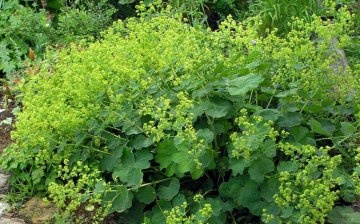
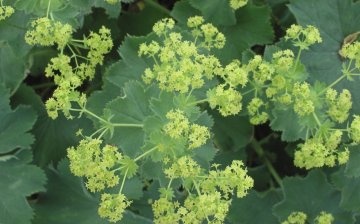
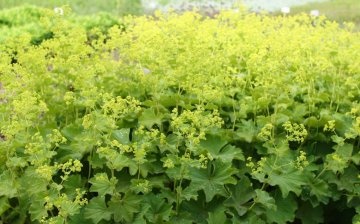
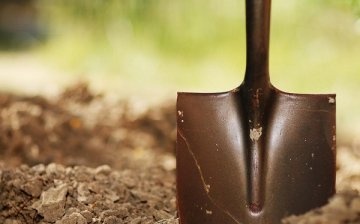
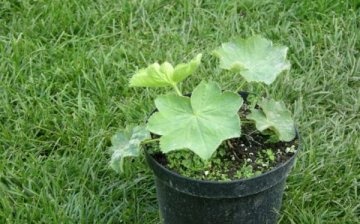

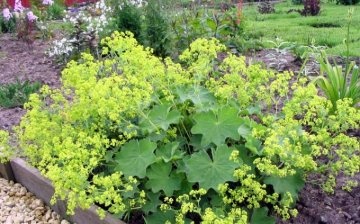
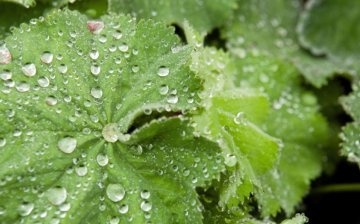
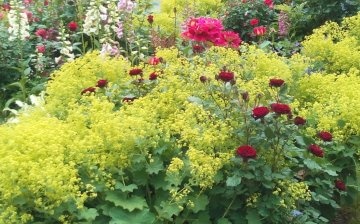










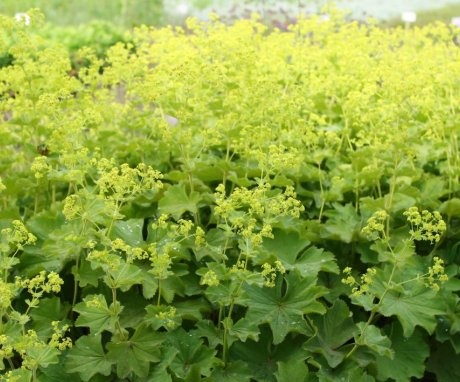

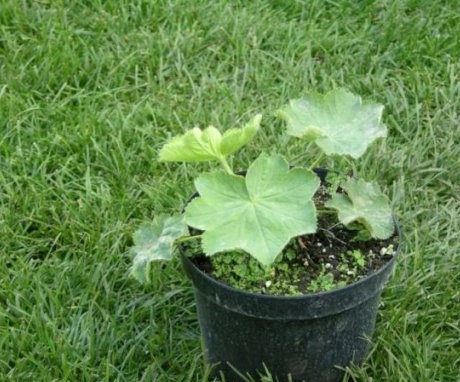
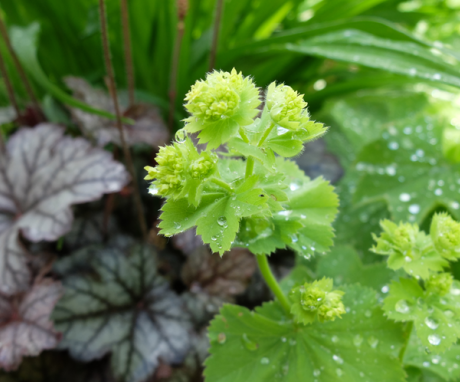
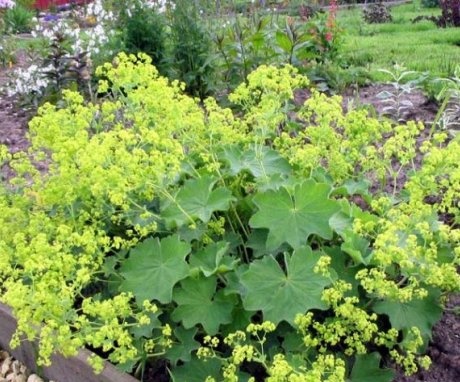
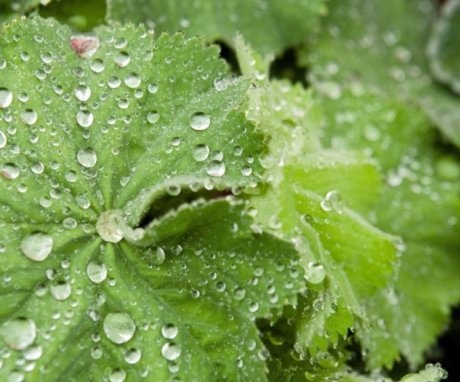

I tried to remember, but such weed grass on my site was not noticed by me. In principle, you can use it as an element for decorating a garden, but I would not plant whole flower beds with this plant.
I remember from childhood that my mother pulled it out like a weed, but every year it sprouted again. Therefore, I do not understand why this plant is also protected from the cold, it is adapted. And about adding to food is very dubious advice, so you can add any herb.